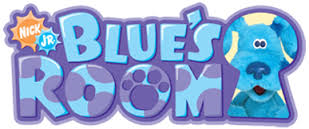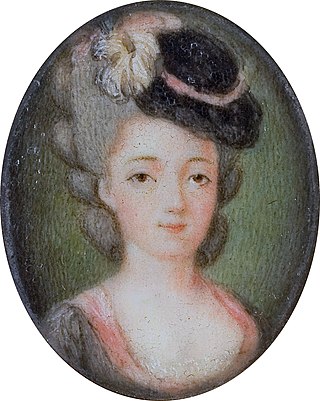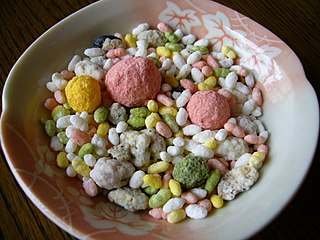
Barbie is a fashion doll created by American businesswoman Ruth Handler, manufactured by American toy company Mattel and launched in 1959. The toy is the figurehead of the Barbie brand that includes a range of fashion dolls and accessories. Barbie has been an important part of the toy fashion doll market for over six decades. Mattel has sold over a billion Barbie dolls, making it the company's largest and most profitable line. The brand has expanded into a multimedia franchise since the late 1980s, including video games, computer-animated films, and a live-action film.

Kenneth Sean "Ken" Carson is a fashion doll introduced by American toy company Mattel in 1961 as the counterpart of Barbie, who was introduced two years earlier.

A doll is a model typically of a human or humanoid character, often used as a toy for children. Dolls have also been used in traditional religious rituals throughout the world. Traditional dolls made of materials such as clay and wood are found in the Americas, Asia, Africa and Europe. The earliest documented dolls go back to the ancient civilizations of Egypt, Greece, and Rome. They have been made as crude, rudimentary playthings as well as elaborate art. Modern doll manufacturing has its roots in Germany, from the 15th century. With industrialization and new materials such as porcelain and plastic, dolls were increasingly mass-produced. During the 20th century, dolls became increasingly popular as collectibles.

An action figure is a poseable character model figure made most commonly of plastic, and often based upon characters from a film, comic book, military, video game or television program; fictional or historical. These figures are usually marketed toward boys and adult collectors. The term was coined by Hasbro in 1964 to market G.I. Joe to boys.

A sex doll is a type of anthropomorphic sex toy in the size and shape of a sexual partner. The sex doll may consist of an entire body, or just a head, pelvis, or other body part intended for sexual stimulation. The parts sometimes vibrate and may be moveable and interchangeable. Sex dolls exist in many forms, but are usually distinguished from sex robots, which are anthropomorphic creations designed to be able to engage in more complex interactions.

A Daruma doll is a hollow, round, Japanese traditional doll modeled after Bodhidharma, the founder of the Zen tradition of Buddhism. These dolls, though typically red and depicting the Indian monk, Bodhidharma, vary greatly in color and design depending on region and artist. Though considered a toy by some, Daruma has a design that is rich in symbolism and is regarded more as a talisman of good luck to the Japanese. Daruma dolls are seen as a symbol of perseverance and good luck, making them a popular gift of encouragement. The doll has also been commercialized by many Buddhist temples to use alongside the setting of goals.
A matrioshka brain is a hypothetical megastructure of immense computational capacity powered by a Dyson sphere. It was proposed in 1997 by Robert J. Bradbury (1956–2011). It is an example of a class-B stellar engine, employing the entire energy output of a star to drive computer systems. This concept derives its name from the nesting Russian matryoshka dolls. The concept was deployed by Bradbury in the anthology Year Million: Science at the Far Edge of Knowledge.

A pincushion is a small, stuffed cushion, typically 3–5 cm (1.2–2.0 in) across, which is used in sewing to store pins or needles with their heads protruding to take hold of them easily, collect them, and keep them organized.
American Girl is an American line of 18-inch (46 cm) dolls released on May 5, 1986, by Pleasant Company. The dolls portray eight- to fourteen-year-old girls of various ethnicities, faiths, and social classes from different time periods throughout history. They are sold with accompanying books told from the viewpoint of the girls. Originally the stories focused on various periods of American history, but were expanded to include characters and stories from contemporary life. Aside from the original American Girl dolls, buyers also have the option to purchase Truly Me dolls where customers can create a doll that looks like themselves. The options for the line of Truly Me dolls include eye color, face mold, skin color, hair texture, and hair length. A variety of related clothing and accessories is also available. A service for ordering a custom-made doll with features and clothing specified by the owner dubbed Create Your Own, was introduced in 2017.

Punk pathetique is a subgenre of British punk rock that involved humour and working-class cultural themes.

Paper dolls are figures cut out of paper or thin card, with separate clothes, also made of paper, that are usually held onto the dolls by paper folding tabs. They may be a figure of a person, animal or inanimate object. Paper dolls have been inexpensive children's toys for almost two hundred years. Today, many artists are turning paper dolls into an art form.

The Pussycat Dolls were an American girl group and dance ensemble, founded in Los Angeles, California, by choreographer Robin Antin in 1995 as a burlesque troupe. At the suggestion of Jimmy Iovine, Antin decided to take the burlesque troupe mainstream as a pop group. Antin negotiated a record deal with Interscope Geffen A&M Records in 2003 turning the group into a music franchise comprising Nicole Scherzinger, Carmit Bachar, Ashley Roberts, Jessica Sutta, Melody Thornton, and Kimberly Wyatt. Their debut single, "Sway", was featured on the soundtrack of the 2004 film Shall We Dance?.

Channapatna toys are a particular form of wooden toys and dolls that are manufactured in the town of Channapatna in the Ramanagara district of Karnataka state, India. This traditional craft is protected as a geographical indication (GI) under the World Trade Organization, administered by the Government of Karnataka. As a result of the popularity of these toys, Channapatna is known as the Gombegala Ooru (toy-town) of Karnataka. Traditionally, the work involved lacquering the wood of the Wrightia tinctoria tree, colloquially called Aale mara (ivory-wood).

Blue's Room is an American puppet television series spin-off from Blue's Clues. It was created by Traci Paige Johnson and Angela Santomero. The show aired on Nickelodeon as part of the Nick Jr. block, and it started out as short segments on Blue's Clues episodes in Season 6.

A reborn doll is a hand made art doll created from a blank kit or a manufactured doll that has been transformed by an artist to resemble a human infant with as much realism as possible. The process of creating a reborn doll is referred to as reborning and the doll artists are referred to as reborners. Reborn dolls are also known as lifelike dolls or reborn baby dolls.
Paper toys are toys made of paper. They are constructed in several ways, by folding, as in paper airplanes, paper fortune tellers or Origami, or by cutting, decorating or assembling pieces of paper with glue or tape to create a paper doll or paper model.

Bolinho de chuva is a dessert both in Portugal and Brazil. It is made from flour, eggs, milk and baking powder or baking soda. The doughnuts are deep-fried and sprinkled with cinnamon and sugar. The name refers to the raindrop shape the batter makes when it hits the oil and to the idea that it is a good rainy day project to make the dish.

A doll hat is a women's millinery design scaled down to suggest a hat that could be worn by a doll. It can be of any design and is generally worn at the front of the head. The hat is usually held in place with a band of fabric or elastic secured at the back of the head.
A hōko is a kind of soft-bodied doll given to young women of age and especially to pregnant women in Japan to protect both mother and unborn child. Traditionally, hōko dolls were made of silk and human hair, and stuffed with cotton. The dolls could be made for both boys and girls. Boys' dolls would be given up and "consecrated" at a shrine when boys came of age at 15 years old, while girls would give up their dolls at marriage. The dolls were given to children either at birth, or on special days shortly after birth. Pregnant woman would be given new ones, so as to protect her and her unborn child together, for the duration of the pregnancy.

Arare is a type of bite-sized Japanese cracker made from glutinous rice and flavored with soy sauce. The size and shapes are what distinguish arare from senbei. The name is chosen to evoke hailstones – smaller arare are similar in size and shape to hailstones, though others can vary significantly in size, flavor and shape. Arare is also called kakimochi or mochi crunch in Hawaii where it was introduced in the 1900s.
















